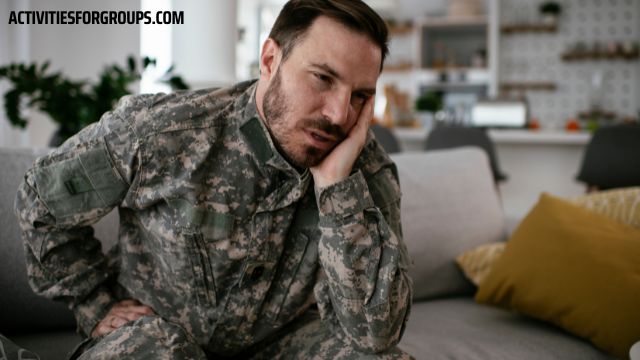While veterans and veterans PTSD patients frequently receive individual therapy, group therapy may be more helpful for some patients.
Members of the group can create a secure, encouraging, and supportive environment in which they can develop together as they strive to live their best lives.

When they indulge in healing together, the process doesn’t get tedious. They tend to heal themselves for the sake of others. It gradually heals their wounds.
Go through these group activities for veterans and veterans with PSTD!
Also, you have to check out my post on 10 Fun Activities For Quadrilaterals That You Must Love To Try In 2024.
What Are PTSD Triggers?
PTSD triggers are related to your traumatic event. You may have triggers in the form of images, sounds, scents, or even thoughts that in some way evoke the traumatic incident.
A clear PTSD trigger might be watching a news broadcast on an incident or watching someone fall off a cliff. Understanding your triggers could help you overcome your PTSD better.
20 Group Activities For Veterans And Veterans With PTSD

PTSD has a long-term effect on you. It will take you a lot of time to process your trauma. When you are with your group, time flies. Try these activities!
- Aromatherapy
Aromatherapy is a safe and effective therapy in and of itself, as well as a component of a healing treatment. It provides pleasure through massage, fragrance, and visual stimulation. Doing this helps in creating an environment in the body and the mind where healing can occur naturally.
- Pets
Adopting a pet together that has been carefully taught to spot and prevent PTSD symptoms can help people manage the destructive symptoms of PTSD. Fostering a trained pet helps people manage sadness, anxiety, and other PTSD-related symptoms including nightmares, which has a positive effect, at least on a short-term basis.
- Talking
Spend time discussing various constructive and destructive coping mechanisms. A few good coping mechanisms are talking to a companion, playing a video game, or drawing.
Screaming, yelling, and making threats to other people are examples of unhealthy coping mechanisms. Ask group participants to choose one unhealthy coping mechanism they are willing to attempt replacing over the course of the coming week. Allocate time for progress evaluation in subsequent group sessions.
- Breathing Exercises
Spend some time discussing the usage of breathing techniques as a tool for controlling one’s emotions. Give everyone in the group some time to practice various breathing techniques, such as box breathing. Spend time considering the experiences of the group members and whether they picture themselves employing these techniques.
- Self-care
Give the group the resources they need to create a self-care strategy that takes into account their requirements in terms of mental, physical, emotional, and spiritual health. Until the next group session, have the participants name two new habits they can adopt to encourage self-care. Give them time during their subsequent appointment to follow up.
- Crisis Plan
Give the group members a worksheet to use in determining a crisis strategy. This can involve figuring out well-known triggers, practical coping mechanisms, constructive boundaries, wholesome diversions, secure supports in their lives, emergency phone numbers, and other tools that can be used in times of crisis.
- Safe Place
Give the group the tools they need to produce a drawing that depicts what the group members would expect a safe environment to look like. This could be a genuine or imagined site.
To employ grounding techniques to help individuals visualize something in their safe place, ask group members to select traits that are connected to their five senses. Spend some time discussing how picturing their safe place might ease emotional anguish.
- Self Esteem
Give the group members the supplies they’ll need to make a “self-esteem container.” Members of the group should discuss what activities and self-care routines help them feel good about themselves. Ask the group to name the things that empty their bucket, such as toxic relationships, self-talk that is negative, poor boundaries, etc.
- Grounding Skill
Spend some time discussing how to use grounding techniques as a tool for controlling emotions. After discussing it, have everyone name a sensory experience they are having in their immediate environment. Examine how their own challenges can be impacted by this practice.
- Music
Tell the group to come up with a song that they can all connect to for the upcoming group meeting. Give the group time to listen to it before allowing a member to share how the song speaks to them personally. The topic of using music as one of the best coping mechanisms for unpleasant and upsetting feelings might be discussed for some time.
- Letters
When everyone in the group is having a hard time, have them compose a letter to themselves. This letter may include words of support, advice on coping mechanisms, or other beneficial remarks. The letters can be kept by members in a secure location for them to refer to when they are having difficulties.
- Skills
Give the group a long list of coping mechanisms or techniques for managing emotions. Before your next session, ask them to list 5 helpful abilities and 5 new coping mechanisms they plan to employ when they feel pressured. In the following group meeting, allow time for them to reflect on their experience.
- Knowledge
Discuss the differences between ideas, feelings, actions, and occurrences in detail. Inform the group of their connections and mutual effects. Give each of the four to the group, and take the time to explain to them which is which.
- Affirmation
Spend some time discussing constructive reframing. Participants are urged to name self-defeating thoughts and collaborate to develop constructive reframing.
- Normalization
Spend some time talking about cognitive distortions and accepting that they exist in everyday life. Ask the group to name any cognitive distortions they may have and how those distortions affect their feelings, beliefs, and actions.
- Jeopardy
Create and enjoy a custom jeopardy game that centers on beneficial subjects like mindfulness, coping mechanisms, support programs, and healthy habits.
- Tree of Life
Give the group the supplies they need to make a “Tree of Life.” Members of the group can be urged to decorate their trees to symbolize the various facets of their lives. Take your time looking at each member’s tree.
- Coping Mechanism
Give each member a worksheet outlining the various ways that emotions can affect our body. For instance, when someone is dissatisfied, they could feel nauseated, or they might feel weak if they feel abandoned. Ask team members to identify with something, and then go over various coping mechanisms they can employ to deal with their feelings.
- Equal Participation
Have everyone in the group take part in a check-in when you first start it. This can involve asking them to consider their current mental health on a scale of 1 to 10 and to respond thoughtfully to a question. In addition, group members can request time during the group session to speak.
- Cycling
Longtime associations between physical activity and improved mental health exist. This medical truth is applicable to many activities, including cycling and surfing. The chemicals that our brains release as a result of physical activity and the vitamin D that our bodies acquire from the sun are two factors that can help veterans who have just returned from combat improve their mental health.
What Are The 5 Stages of PTSD?
Though they say that your trauma makes you stronger, PTSD is something that makes you vulnerable. There are basically 5 stages of PTSD.
Stage 1: Impact or Emergency
This is the period right after the traumatic occurrence when the person is still processing what they saw or was a part of.
Stage 2: Denial
Not everyone with PTSD goes through the denial or numbing stages. People with PTSD will attempt to numb or protect themselves during this stage by denying that the event ever happened.
Stage 3: Rescue
The afflicted person starts to accept what happened to them during the rescue phase. Going back to the trauma site may be a part of this stage.
Stage 4: Intermediate
After meeting his or her basic security and sustenance needs, the PTSD sufferer enters this stage of rehabilitation and starts to get used to living a “normal” life again.
Stage 5: Recovery
A person with PTSD has entered the fifth stage of reconstruction when they start to process and carry out a recovery program. The Integration Stage is another name for this.
What Are The Major Clusters Of PSTD?

Post Traumatic Stress Disorder is very difficult to live with. You never know what triggers you. The four main PTSD clusters are as follows:
Reliving traumatic experiences: These include memories, nightmares, and flashbacks. These symptoms can be brought on by a wide variety of factors, including people, places, objects, fragrances, melodies, etc.
Avoidance: This refers to staying away from anything that could potentially act as a trigger. Agoraphobia and self-isolation may result from this.
Cognitive symptoms: These include having a gloomy outlook on the world and oneself. guilt, toxic shame, an inability to experience joy, a lack of confidence in other people, and suppressed memories.
Hyperarousal Symptoms: These always exist in place of the objects or people that initially cause the trauma. intense tension, rage, anxiety, sadness, and the tendency to startle easily. These can trigger dangerous actions like drug or alcohol abuse in an effort to relax.
Verdict
PTSD group treatment activities give therapists a chance to lead an interesting and informative group session. It also makes the sessions joyful for the participants as these are very easy to conduct.
Try these group activities for veterans and veterans with PSTD! May you heal soon!




Leave a Reply